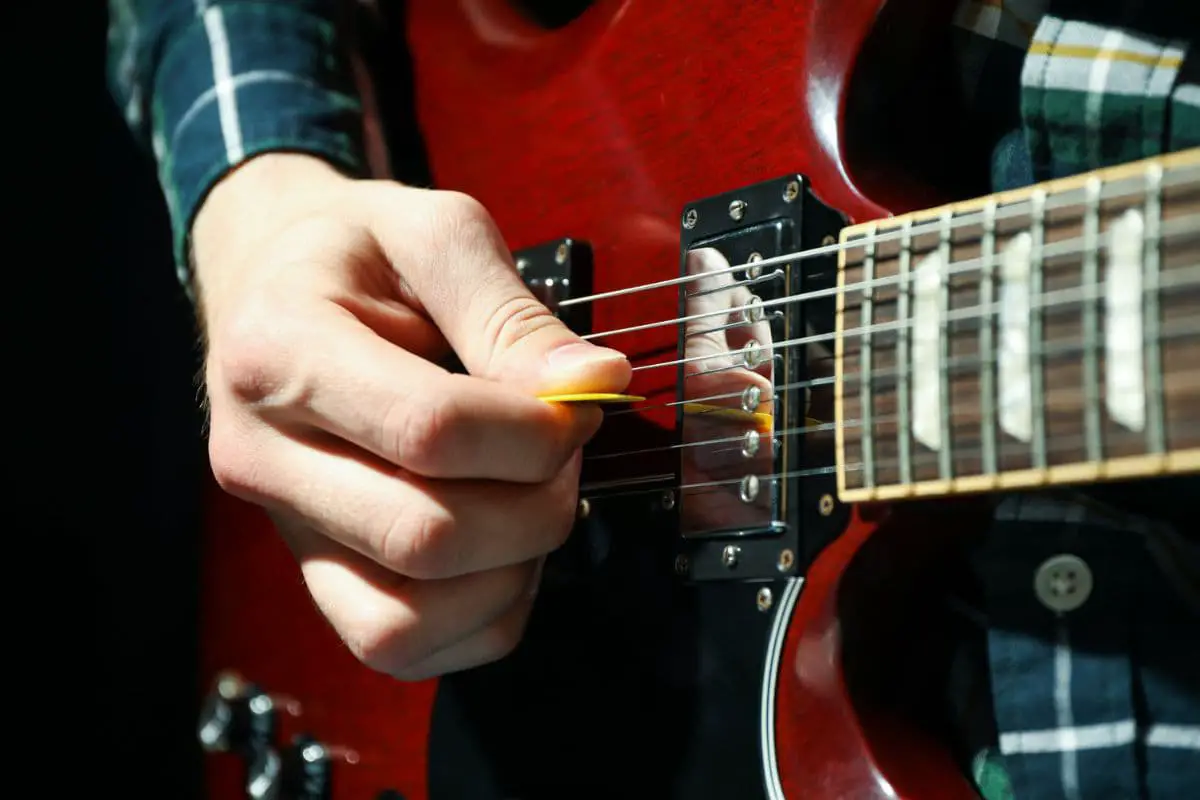A pick scratch, also known as a pick scrape or pick slide, is a simple but cool and effective sound you can make on your guitar. It’s a great way to start a song or to jump into a new section after a big buildup. Even though it’s quite a simple technique, there are a few tips and tricks you should keep in mind if you want to pull it off effectively and use it to the full potential.
To make a pick scratch sound on a guitar, you need to use a lot of gain, and pay attention to how you hold your pick. Apply pressure behind the bridge pickup on the A and E strings and push your hand toward the neck. It’s easiest to have your thumb pointing forward.
Keep reading if you want to learn how to do a great pick scratch on a guitar, as it can liven up your songs and make your build ups more effective. We’ll dive deep into the details, so you’ll be doing amazing pick scrapes in no time.
If you want to find out what my recommended guitar gear is, then here is what I recommend on Amazon:
- Fender Cutaway Acoustic-Electric Guitar Bundle (MY FAVORITE GUITAR)
- Snark SN-8 Super Tight All Instrument Tuner (Easiest Tuner I’ve Used)
- 6 String Acoustic Guitar Capo (Best CAPO for quick changes)
- Dunlop Max Grip 1.0mm Nylon Picks (Thick Guitar Pick So You Don’t Lose Grip!)
- Universal Guitar Stand (Cheap & Minimalist Guitar Stand I Recommend)
- Levy’s 2″ Wide Quick Adjust Guitar Strap (Best Guitar Strap For Any Level)
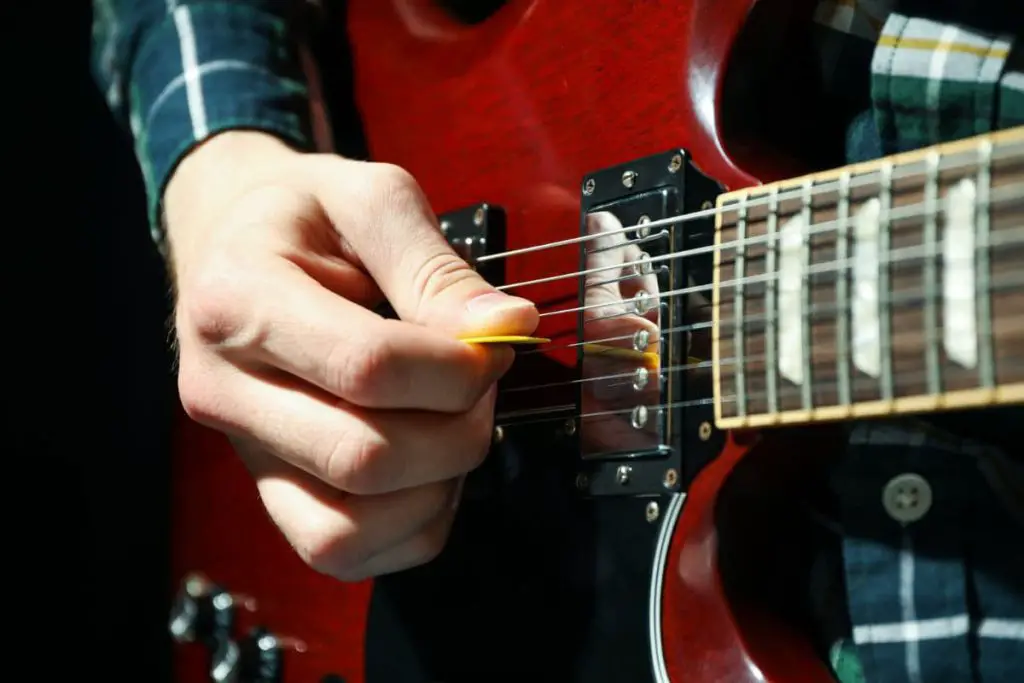
1. Use a Lot of Gain
If you want to avoid a thin-sounding pick scratch, you should first work on getting a thick tone to begin with. You’ll need a lot of gain to achieve this, and it’s best if the gain knob on your amp is turned all the way up or close to that point.
It’s also important to keep your mids relatively high and your bass slightly above the treble. The amp’s master volume should also be relatively high. This isn’t a technique you can use while practicing in a crowded dorm or a house where everyone is asleep. If your guitar is not loud enough, the pick scratch will sound more like a whistle than anything, which is not a sound that will impress many people.
You should also add a distortion or overdrive pedal to the mix, which allows pick scrapes to make their telltale sweet and crunchy sound. There’s no need to ramp them up to the maximum, but a certain amount of overdrive and distortion will help.
Apart from distortion and overdrive, delay and reverb can also be used effectively to make your pick scrapes sound better. They will add texture to your sound and allow you to create a more unique pick scrape.
Bear in mind that just because it’s a simple technique, it doesn’t mean that it always has to sound the same.
Pick scrapes are essentially background noise that you use to your advantage. If your guitar sounds too thin, your pick scrapes might sound like regular noise that simply annoys people instead of pumping them up for your song.
The key to the difference between bad noise and cool noise is in the tone. You don’t want a pick scrape that sounds like somebody’s pained screeching. You want a rich and thick sound that will immediately draw attention and keep your audience on their toes, and expecting a heavy riff or a catchy chorus.
2. Pay Attention to How You Hold Your Pick
If you like to hold your pick so that only a small part of it pokes out and you have better control over it, you’ll have to change this to get better pick slides. When doing a pick slide, you have to hold your pick so that as much of it pokes out of your hand as possible. Pick slides sound best when a large part of your pick makes contact with the strings.

You also have to hold your pick by the tip so that two of its angles make contact with the strings instead of only one. Otherwise, you’ll scratch only one string instead of two (or more), and the sound you get won’t be much except noise and literal scratching. That’s not something anybody will enjoy, especially with a lot of gain, distortion, and volume turned all the way up.
Your hand position is also an important factor. Some guitarists like to lead with their pinky fingers. However, this isn’t the easiest way to do a pick slide. Firstly, it forces you into a weird hand position, and there’s no reason why you should be uncomfortable while playing. Secondly, this position doesn’t allow you to go back to strumming as quickly as possible.
Instead of leading with your pinky, lead with your thumb. This hand position is much more comfortable, and you can immediately return to strumming. Plus, it lowers the chances of dropping your pick since it’s much more convenient. Imagine the embarrassment of building up an ear-melting solo, only to drop your pick and stand there awkwardly. Nobody would like to go through that.
So, hold your pick tightly and get into a comfortable hand position. This will help your pick scratches immensely.
3. Start From the Bridge Pickup
To get a really thick and tight pick scratch, you have to find the best starting position. Starting from the wrong position will make your pick scratch too short and thin-sounding. That’s why you should start between your bridge and bridge pickup and slide toward the neck.
You’ll notice that the pitch descends as you go toward your neck. It will ascend as you proceed toward your bridge, but the most common way to utilize this technique is going from bridge to neck. However, nothing prevents you from going in the opposite direction if you want to get creative with your pick slides.
For the best sound, use the thickest strings, E and A. If possible, you can slide across three or even four strings, but that’s somewhat difficult to pull off and unnecessary. If you can find a good position on the bottom strings, you’ll be just fine.
Your pick should be at a 90-degree angle against the strings. You don’t have to be too exact with this, but the closer you get to this angle, the better. If the angle is too big or too small, you might not be able to apply enough pressure on the strings, and you’ll get a thin scratching sound instead of a thick slide that you can actually use in your playing.
4. Don’t Overdo It
Yes, pick scratches sound great. However, that doesn’t mean you are supposed to spam pick slides at every chance. Like most other techniques, they work best when used sparingly and at the right moments. This is particularly true for noisy techniques such as this one.
Guitarists usually use pick scratches to bridge the gap between the intro and the first verse, a verse and the solo, or in rare cases, a verse and a chorus. You’re not supposed to use a pick slide more than once or maybe twice in a song. It’s very difficult to include one in a song more often than that while still being able to make it sound good.
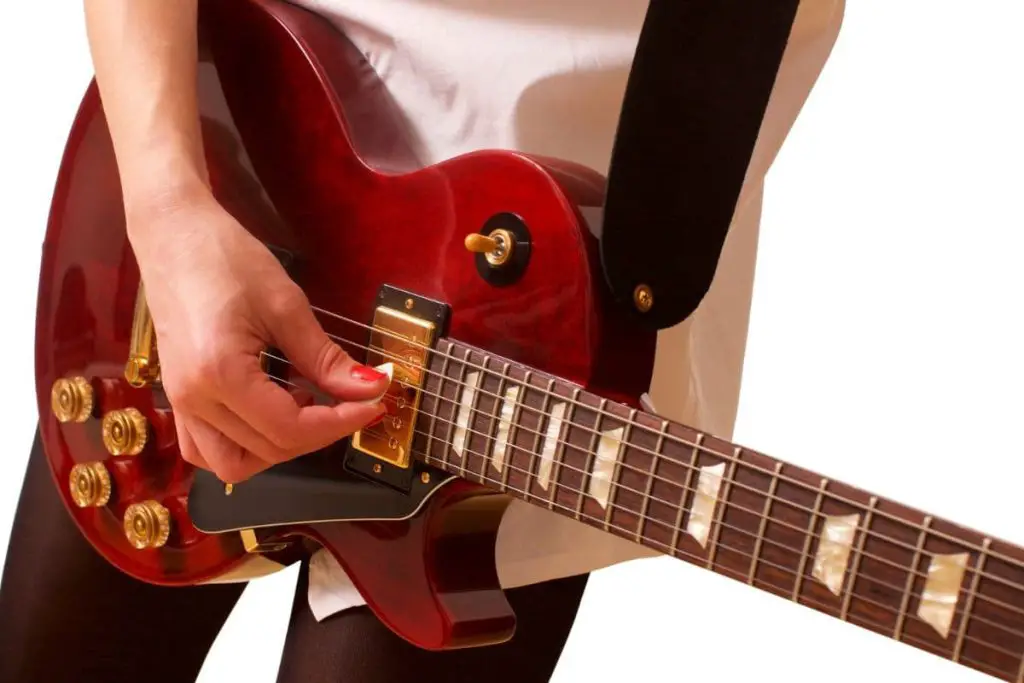
You should also avoid using pick slides in every single song. That way, it becomes expected and thus boring. Repeating the same sound all the time won’t excite your audience much.
Including pick slides on one or two songs on an album is a great idea, and you should try to use them in different parts of the song. For example, if you use it to introduce the first verse in one, use it to introduce the solo in another one.
You should also note that pick scratches damage your strings. After all, you’re roughly scratching them with your pick, and that won’t help prolong the life of your strings. This technique also destroys your picks, especially if you prefer a thin, soft pick. While they’re not meant to be used for years on end, you’re not supposed to throw them away all the time, either.
You should also avoid making your pick scratches too long. They usually don’t last longer than a measure, and that’s more than enough to get that dramatic effect you’re looking for. If you’re looking to create a noisy, psychedelic sound, you might get away with using longer pick slides. However, in most cases, this won’t be possible, so just stick to short, one-measure slides.
5. Combine Pick Scratches With Other Sounds
While pick scratches sound cool on their own, they can be skillfully used in conjunction with some other tricks to get an even cooler effect. This allows them to be a very versatile tool you can use to write riffs and solos.
For example, you can combine a pick scrape with a slide across your strings. This requires precise timing and coordination but can produce a cool effect that enhances the buildup the pick slide creates.
Here are the steps to perform if you want to achieve this amazing effect:
- Slide from the bridge pickup to the neck.
- As your pick approaches the neck, hammer-on the high frets of the low strings.
- Slide your fretting hand across the neck toward the headstock.
- Strum a power chord on the low frets of the low strings.
You can even combine this with a revving sound if you want to cover two measures with a noisy effect without making it too long and boring. Revving requires you to start from the low frets, slide up, and then back down.
You can combine the two effects by revving up, scraping down, and then revving back down. This technique will require some practice, so don’t be discouraged if you don’t nail it immediately. When you do get it right, you’ll have an awesome way to introduce earth-shattering riffs.
Don’t be afraid to experiment and combine your pick slides with various noises your guitar makes. Just because it’s a simple technique, it doesn’t mean you can’t use it creatively and combine it with different techniques. This turns it into a cool riff-writing tool from just a cool noise.
Can You Pick Slide on a Bass Guitar?
Since pick slides sound so good on electric guitars, you might want to use the technique on a bass guitar to follow an electric guitar. While this is technically possible, you won’t achieve the same effect. Most likely, the sound you get will be very unpleasant and won’t cut through the mix, rendering it useless.
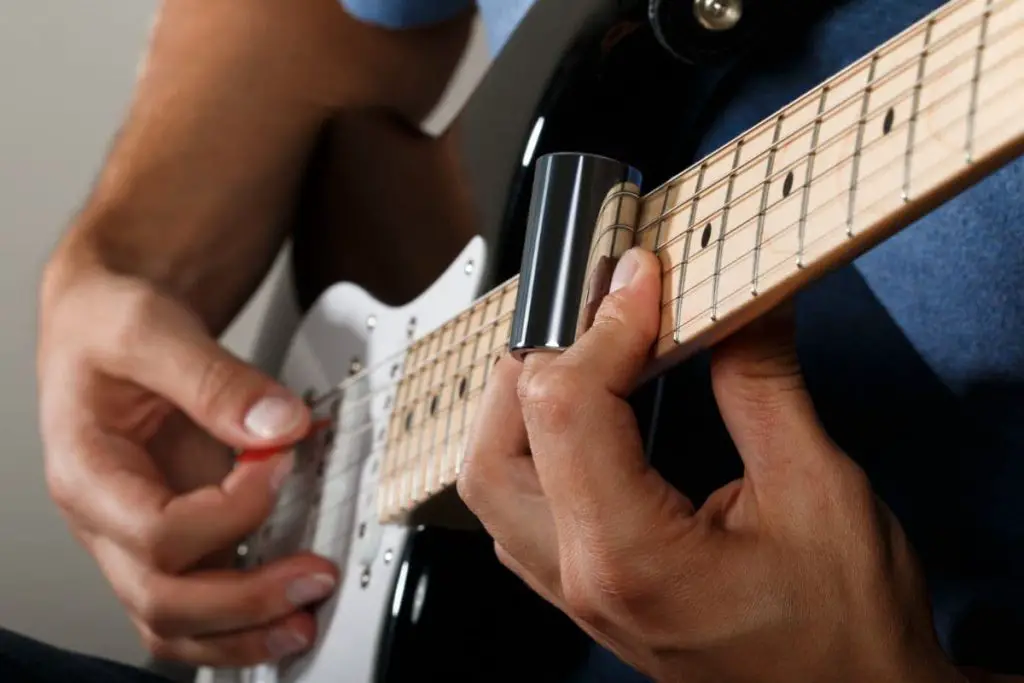
There are several reasons for this. The thickness of the strings on a bass won’t allow you to achieve the same effect you get on an electric guitar. It’s much more difficult to make those thick strings vibrate.
You have to apply much more force to do so, and sliding a pick over the strings will mostly just sound like you’re scraping the strings in an attempt to clean them. This isn’t a particularly musical sound, so it won’t be enjoyable, and you won’t be able to use it as a songwriting tool.
I’ve also mentioned that pick slides require a lot of overdrive or distortion to sound good. Bassists don’t often use distortion and overdrive because they’re simply unnecessary. This will make a pick slide on a bass sound terrible and pointless.
You can hear an attempt to do a pick slide on a bass in the following video:
You can see that this is most definitely not a sound you’d want to hear in a song. The instructor in the video just ruined his pick and didn’t achieve any desirable effect. This is another reason why you should avoid doing pick slides on a bass guitar because you’ll ruin the pick right away, unless it is really thick and sturdy.
The only way you might be able to pull off a pick scratch on a bass is with really thin strings and a heavily overdriven bass. You would also need a very thick and sturdy pick, preferably three millimeters thick (I doubt that there are thicker picks). You should also avoid scraping the bottom two strings. Instead, go for the thinnest strings and scrape there.
However, it’s best to avoid doing pick scrapes altogether if you are a bassist. While the guitarist is doing a pick scrape, you can let the last note from the previous measure ring. If that doesn’t sound good, you can repeat the previous measure, or even better, throw in a groovy fill to connect the previous section to the next one, which is what a pick scrape does, anyway.
Or, if nothing else, rest for a measure and have a sip of coffee. It will probably benefit your song much more than a bass pick slide.
Can You Pick Slide on an Acoustic Guitar?
There’s a lower number of cool noises you can pull off on an acoustic guitar simply because of how it works compared to an electric guitar. The pickups on an electric guitar capture the strings’ vibrations, which are then transferred to the amp.
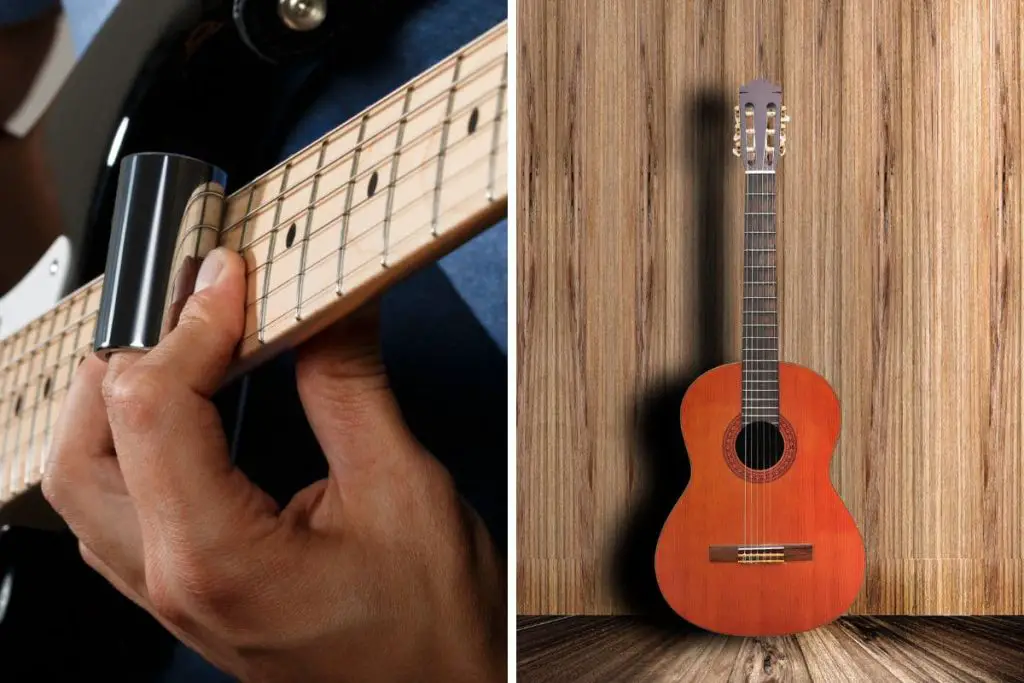
The pickup will capture all the disturbances in their magnetic fields produced by the strings, not just the proper notes you play. With a bit of skill and taste, you can turn these noises (such as pick slides) into usable tools for music, even if your guitar wasn’t quite made for that.
An acoustic guitar doesn’t work this way. The vibrations from the strings stir the air inside a guitar’s body, and the air vibrations come out as sound. Of course, it’s a bit more complex than this, but this simple explanation will suffice here.
There is no magnetic field that you can disturb and manipulate the noises. That’s why you can’t pull off sounds like pick scrapes, revving, and similar stuff. You can play clean notes and that’s about it.
If you scrape your acoustic guitar strings, you will likely damage them and get a very unpleasant scraping noise. Unless you really enjoy listening to pieces of metal being scraped, you probably won’t enjoy this sound, which is why you can’t do a pick slide on an acoustic guitar.
You might try to do a pick slide on an acoustic-electric guitar with a soundhole pickup. Soundhole pickups are electromagnetic pickups, similar to the ones on electric guitars, so the sound effect might be similar to the one you get from an electric guitar.
If you really want to try this for yourself, you might plug your acoustic-electric guitar into an electric guitar amp to get the sound as close to an electric guitar as possible. However, it might be best to reserve your pick scrapes for your electric guitar. As far as I know, nobody has used pick slides on an acoustic-electric guitar, and there’s probably a good reason for that.
On the other hand, you might get lucky and get a cool effect. Be sure to credit this article if that happens!
Final Thoughts
That does it for this post. As you can see, a pick scratch isn’t difficult to pull off. You have to scrape from behind the bridge pickup to the neck pickup with the wider end of your pick. It’s advisable to use pick scratches with other techniques to achieve an even cooler effect.
You shouldn’t overuse pick scratches, though, and when you do use them, make sure it’s effective. Good luck with your playing!
If you want to find out what my recommended guitar gear is, then here is what I recommend on Amazon:
- Fender Cutaway Acoustic-Electric Guitar Bundle (MY FAVORITE GUITAR)
- Snark SN-8 Super Tight All Instrument Tuner (Easiest Tuner I’ve Used)
- 6 String Acoustic Guitar Capo (Best CAPO for quick changes)
- Dunlop Max Grip 1.0mm Nylon Picks (Thick Guitar Pick So You Don’t Lose Grip!)
- Universal Guitar Stand (Cheap & Minimalist Guitar Stand I Recommend)
- Levy’s 2″ Wide Quick Adjust Guitar Strap (Best Guitar Strap For Any Level)
Related Posts:

